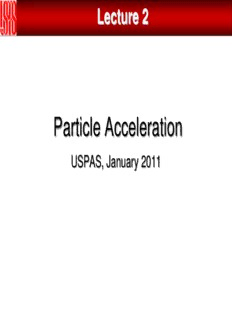
Lecture 2 - Particle Acceleration - US Particle Accelerator School PDF
Preview Lecture 2 - Particle Acceleration - US Particle Accelerator School
Lecture 2 Particle Acceleration USPAS, January 2011 Outline • Electrostatic accelerators • Radio-frequency (RF) linear accelerators • RF Cavities and their properties • Material is covered in Wangler, Chapter 1 (and also in Wiedemann Chapter 15) How do we accelerate particles? • We can accelerate charged particles: – electrons (e-) and positrons (e+) – protons (p) and antiprotons (p) – Ions (e.g. H1-,Ne2+, Au92+, …) • These particles are typically “born” at low- energy – e- : emission from thermionic gun at ~100 kV – p/ions: sources at ~50 kV • The application usually requires that we accelerate these particles to higher energy, in order to make use of them Electromagnetic Forces on Charged Particles • Lorentz force equation gives the force in response to electric and magnetic fields: • The equation of motion becomes: • The kinetic energy of a charged particle increases by an amount equal to the work done (Work-Energy Theorem) W F dl q E dl q (v B) dl W q E dl q (v B) vdt q E dl Electromagnetic Forces on Charged Particles • We therefore reach the important conclusion that – Magnetic fields cannot be used to change the kinetic energy of a particle • We must rely on electric fields for particle acceleration – Acceleration occurs along the direction of the electric field – Energy gain is independent of the particle velocity • In accelerators: – Longitudinal electric fields (along the direction of particle motion) are used for acceleration – Magnetic fields are used to bend particles for guidance and focusing Acceleration by Static Fields: Electrostatic Accelerators Acceleration by Static Electric Fields • We can produce an electric field by establishing a potential difference V between two parallel plate electrodes, 0 separated by a distance L: L E V / L z 0 +q • A charged particle released from the + electrode acquires an increase in kinetic energy at the E – electrode of + - L L W F dz q E dz qV V z z 0 0 0 0 The Simplest Electrostatic Accelerators: Electron Guns Electrostatic Accelerators • Some small accelerators, such as electron guns for TV picture tubes, use the parallel plate geometry just presented • Electrostatic particle accelerators generally use a slightly modified geometry in which a constant electric field is produced across an accelerating gap • Energy gain: Accelerating column in W nq V electrostatic n accelerator • Limited by the generator V V generator n Cascade Generators, aka Cockroft-Walton Accelerators Cockroft and Walton’s 800 kV accelerator, Cavendish Laboratory, Cambridge, 1932 Modern Cockroft- Waltons are still They accelerated protons to 800 kV used as proton injectors for linear and observed the first artificially accelerators produced nuclear reaction: p+Li →2 He This work earned them the Nobel Prize in 1951
Description: